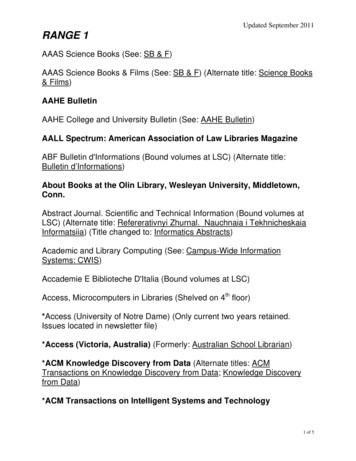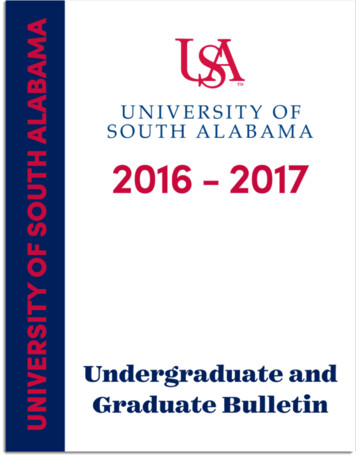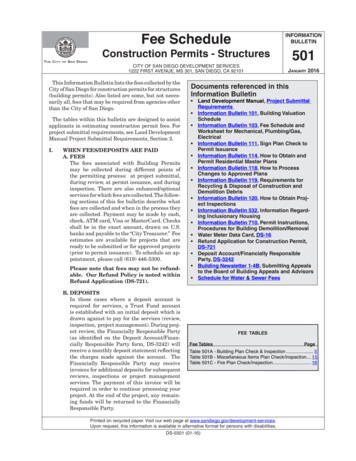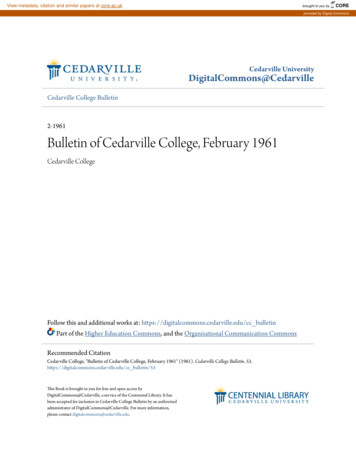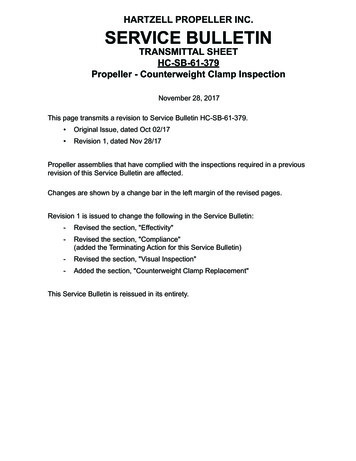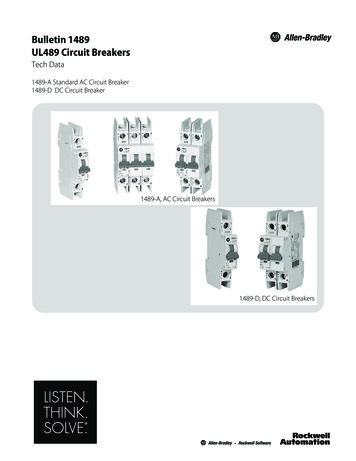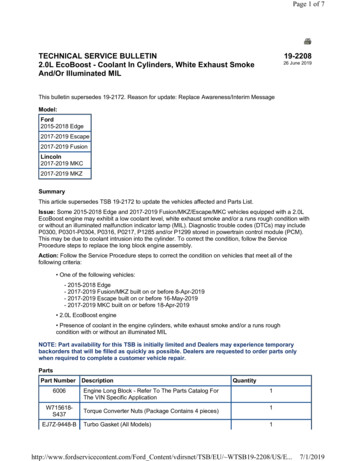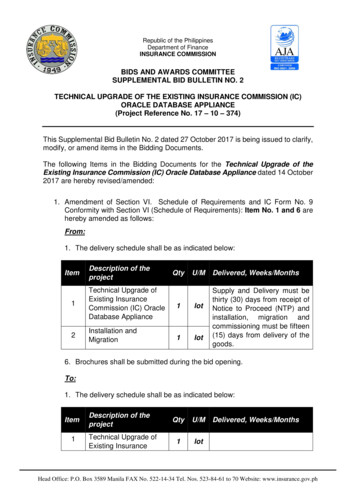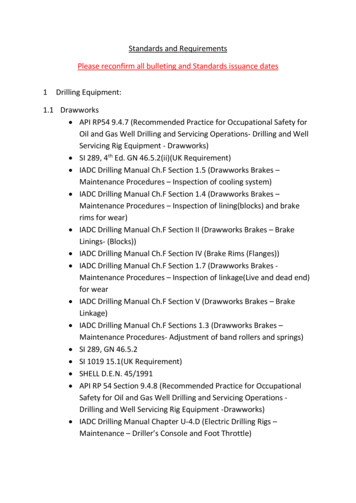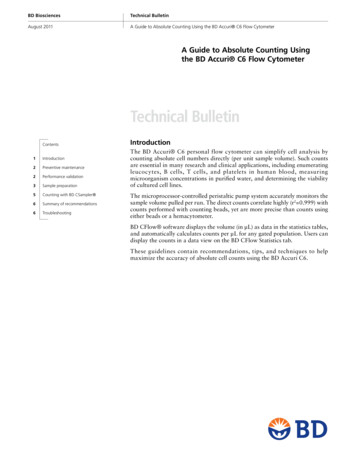
Transcription
BD BiosciencesTechnical BulletinAugust 2011A Guide to Absolute Counting Using the BD Accuri C6 Flow CytometerA Guide to Absolute Counting Usingthe BD Accuri C6 Flow CytometerTechnical BulletinContents1Introduction2Preventive maintenance2Performance validation3Sample preparation5Counting with BD CSampler 6Summary of recommendations6TroubleshootingIntroductionThe BD Accuri C6 personal flow cytometer can simplify cell analysis bycounting absolute cell numbers directly (per unit sample volume). Such countsare essential in many research and clinical applications, including enumeratingleucocytes, B cells, T cells, and platelets in human blood, measuringmicroorganism concentrations in purified water, and determining the viabilityof cultured cell lines.The microprocessor-controlled peristaltic pump system accurately monitors thesample volume pulled per run. The direct counts correlate highly (r2 0.999) withcounts performed with counting beads, yet are more precise than counts usingeither beads or a hemacytometer.BD CFlow software displays the volume (in μL) as data in the statistics tables,and automatically calculates counts per μL for any gated population. Users candisplay the counts in a data view on the BD CFlow Statistics tab.These guidelines contain recommendations, tips, and techniques to helpmaximize the accuracy of absolute cell counts using the BD Accuri C6.
BD BiosciencesTechnical BulletinAugust 2011A Guide to Absolute Counting Using the BD Accuri C6 Flow CytometerPreventive maintenanceAs with any laboratory instrument, optimal performance requires proper systemmaintenance. The following table shows the suggested preventive maintenanceroutine. For detailed procedures, see the BD Accuri C6 Flow CytometerInstrument Manual.Counting Bead: cell count per mLTable 1. Recommended preventive maintenance procedures.FrequencyTaskSupplies and partsAfter every experimentRun filtered DI water at the Fast rate for 3 to 5 minutes toprevent clogging.DI waterDaily (if the cytometer is not shut down)Run the decontamination and cleaning cycles.DI water, Cat. Nos.653154, 653155,and 653157Between usesPlace a tube of DI water on the Sample Introduction Probe(SIP), or if using the BD CSampler option, place the SIP inthe wash station.DI waterMonthlyClean the flow cell by performing an extended flow cell clean.Cat. No. 653159Bi-monthlyReplace the peristaltic pump tubing, in-line sheath filter, andbottle filters.Cat. Nos. 653146,653148, and 65314710,000,000y 1.1232x 1020.2r2 0.9994n 601,000,000Performance 0,00010,000,000Direct Volume: cell count per mL sampleFigure 1. Comparison of absolute cell countsmeasured by direct volume vs counting beads.Serial dilutions of Jurkat cells in PBS werecounted on the BD Accuri C6 by two methods.X-axis values represent absolute cell countsmeasured against volume sampled directly,while y-axis values are relative to the numberof counting beads detected.Prior to running experimental samples, validate accurate counting by using areference count bead in the experimental buffer, using the same sample volumeand tube as in the experiment. If bead counts are within 20% of the expectedvalue (based on information provided by the bead manufacturer), proceed withsample collection. If bead counts are not within 20% of expected values, proceedwith following fluidics calibration procedure.Fluidics calibrationPerform the following in order:1. Ensure that the fluid levels in the Sheath, Cleaning, and Decontaminationbottles are sufficient to cover the inlet tubing and that there are no “kinked”fluidic lines.2. Run a decontamination cycle from the Instrument Menu or by shutting downand restarting the cytometer.3. Within 5 minutes of completing the decontamination cycle, place a 12 x75-mm tube containing 750 µL of 70% ethanol on the SIP. Acquire 400 µLusing the Fast fluidics setting.4. Within 5 minutes of completing the ethanol run, place a 12 x 75-mm tubecontaining 1,500 µL of filtered DI water on the SIP. Acquire 400 µL using theFast fluidics setting.
BD BiosciencesTechnical BulletinAugust 2011A Guide to Absolute Counting Using the BD Accuri C6 Flow CytometerPage 35. Within 5 minutes of completing the water run, place a calibration sample onthe SIP. Select Instrument Calibrate Fluidics. Calibration should be performed in the same tube type as the experimentalsample. Calibration should be performed using a sample of the same or similarviscosity as the samples to be analyzed. For example, if lysed humanperipheral blood samples are to be acquired, lysed human peripheral bloodshould be used during calibration. The calibration procedure consumes approximately 220 µL. To accountfor this, the volume in the calibration sample tube should be 110 µL morethan the average volume used with subsequent test samples. For example,if using 1,000-µL samples, perform calibration with 1,110 µL in the tube.The values determined by the BD Accuri C6 are based on the averagesample height in the tube during the calibration. If sample volumes 50 µL are to be acquired from the sample tube, thecalibration volume should take this into account and the average volumein the sample tube during the acquisition should be used. For example, if100 µL is to be acquired from a 1,000-µL sample, the average volumewould be 950 µL.Average volume (Starting Volume Ending Volume)/2 (1,000 900)/2 950 µL6. The cytometer performs a calibration cycle lasting approximately 13 minutes,during which the status traffic light is yellow. Once completed, the traffic lightreverts to green with the status message C6 and CFlow are connected andready.7. Repeat the performance validation.8. If the status message indicates that calibration failed, perform the followingtroubleshooting. The cytometer will operate normally. However volumemeasurements for the samples might be incorrect, since the cytometer revertsto the factory-set default fluidics calibration settings. Make sure that the calibration tube did not run dry during calibration. Repeat fluidics calibration from step 1 with a new calibration sample. If calibration fails a second time, replace the peristaltic pump tubing inthe cytometer and repeat the calibration routine beginning with step 1.If calibration fails a third time, contact BD Accuri Technical Support.Sample PreparationSample concentrationVolume measurements on the BD Accuri C6 are most accurate with cellconcentrations between 1,000 and 5 x 10 6 cells/mL (see Figure 1). Higherconcentrations might result in inaccurate counting due to system saturation, sodilute samples if necessary.
BD BiosciencesTechnical BulletinAugust 2011A Guide to Absolute Counting Using the BD Accuri C6 Flow CytometerA. Primary SampleThe ideal cell concentration range for accurate counting varies among cell types,based on considerations such as size, shape, and tendency to clump. The flowrate, relative to sample concentration, should minimize doublets and largerclumps, yet never exceed 10,000 events per second. We recommend that you testserial dilutions of the sample and compare reported concentrations to verify alinear correlation.4,544,425F01 2uL FSC 8000 1Gate: (P4 in all)P294.9%10FSC-H2,000,000Cell suspensionAssess and minimize cell clumping, either by dilution or a combination ofenzymatic and mechanical means. Cells particularly prone to clumping may needto be filtered prior to running on a flow cytometer. Cells must be evenly dispersedthroughout the suspension; otherwise, no method can achieve accurate counting.P34.0%10500,000 1,000,000FSC-A1,604,965B. 1:2 Dilution4,544,425F05 1uL FSC 8000 2Gate: (P4 in all)10FSC-H2,000,000P297.4%In the example in Figure 2, if a loss of 4% of cells due to clumping would affectthe experimental accuracy of cell counts, the original cell suspension should bediluted.Sample mediumP32.0%10500,000 1,000,000FSC-A1,604,9654,544,425F11 0.25uL FSC 8000 2Gate: (P4 in all)P299.0%FSC-H2,000,00010Sample viscosity can affect direct-volume measurements. When running samplesin viscous buffers such as blood lysis/fixative solutions, we recommend validatingvolume accuracy using reference beads in the sample buffer, and calibrating thefluidics, if necessary.Sample typeC. 1:4 DilutionAccuri Cytometers has validated the accuracy of absolute cell counts using avariety of cell types including primary cells (human peripheral lymphocytes,human platelets, and mouse splenocytes), cell lines (Jurkat, Chinese HamsterOvary (CHO), and 3T3 mouse fibroblasts), and bacteria.Take care to maintain single-cell dispersion, particularly with cell types proneto clumping. Consider cell-type characteristics, such as size, shape, and tendencyto clump, when determining the appropriate operational concentration range.See the Sample concentration and Cell suspension sections for more details.P30.6%10Figure 2 shows how to assess cell clumping using flow cytometry by plottingFSC-A against FSC-H. When single cells in the flow cell pass through the laserbeam, their FSC-A and FSC-H signals correlate linearly and plot along a relativelystraight line (P2). Clumps of cells will have larger FSC-A signals relative to FSCH, and the signals will fall off the diagonal formed by single cells (P3). Figures2B and 2C show the FSC profiles of the primary sample in Figure 2A after oneand two 1:2 serial dilutions, respectively. Clumping, shown by the percentage ofcells in gate P3, decreases as the sample is increasingly diluted.500,000 1,000,000FSC-ASample volume1,604,965Figure 2. Discriminating cell clumps by plottingFSC-A against FSC-H.The P2 gate contains single cells, indicated bya linear correlation between FSC-A and FSC-Hsignals. The P3 gate contains cell clumps,indicated by an increase in FSC-A compared toFSC-H. Results: A. At original concentration,4% of the primary sample is clumped. B, C.The percentage of cell clumps (P3) decreases asthe sample is increasingly diluted.The minimum sample volume required for accurate counts depends on samplefluid height in relation to the SIP position, which varies by tube type. Becauseaccurate counting is calculated based on a pressure differential between the SIPand the sample liquid, some residual volume is required. In addition,approximately 25 μL of “dead volume” is pulled into the flow cell (but notanalyzed) during fluidics stabilization.Taking these factors into account, you can obtain accurate counts on theBD Accuri C6 with sample volumes as low as 300 μL (assuming a volume runlimit of 10 μL) in BD Falcon 12 x 75-mm tubes. The maximum recommendedsample volume in a 12 x 75-mm tube is 2 mL. Never acquire more than 750 µLfrom a single tube using the Medium fluidics setting, or 1,500 µL using the Fastfluidics setting when accurate counts are desired.
BD BiosciencesTechnical BulletinAugust 2011A Guide to Absolute Counting Using the BD Accuri C6 Flow CytometerPage 5Acquire only once from any sample tube. Sample height within the tube is critical.We recommend aliquoting sample into separate tubes to obtain and averagetriplicate measurements for greatest accuracy.Samples with low concentrations or more clumping may require larger volumesto achieve statistical significance for accurate cell counts. We recommendcounting at least 500 cells of interest per run, and averaging replicate runs toobtain the most accurate counts.Fluidics speedThe BD Accuri C6 offers three standard fluidics settings—Slow, Medium, andFast—with pre-optimized flow rate and core size combinations. Due to themethod used to measure direct volume, do not use the Slow speed to determineabsolute counts.In BD CFlow software, in addition to the standard fluidics settings, you can setcustom flow rates and core sizes. When working with custom settings, theminimum flow rate and core size values for accurate volume measurements are15 μL/min and 16 μm, respectively. Volume accuracy using custom flow rate andcore size combinations should be verified by the user.AcquisitionAlways compare the same stop limit types. For example, do not compareconcentrations collected with volume stop counts to event stop counts.Tube typesSince the BD Accuri C6 is a non-pressurized system, you are not limited tospecific sample tubes. BD Biosciences has validated accurate counting withBD Falcon 12 x 75-mm tubes. For other types of tubes, we recommend verifyingaccuracy of counts using an independent counting method.Counting with the BD CSamplerNote the additional considerations for counting cells when sampling is automatedusing the optional BD CSampler option.AgitationOne key to obtaining accurate counts when using the BD CSampler is to maintaina homogeneous suspension of samples. The agitate function is designed to keepcells in suspension by physically agitating the plate or tube rack. Since agitationoccurs only between aspirations of each well in a plate, it does not interruptsample collection.You can specify the frequency and number (1 to 3 cycles, 15 seconds each) ofagitation cycles per well or tube when setting up automated runs. The appropriateagitate frequency is dependent on several experimental factors including cell type,sample medium, and sample volume, and should be determined by the user.We recommend starting with one agitation cycle per well or tube and adjustingif needed.Tube and plate typeWhen using the BD CSampler for absolute counting, use round- or U-bottom96-well plates, or 12 x 75-mm tubes in the tube rack provided. Agitation is noteffective on samples in V-bottom, flat-bottom, or deep-well 96-well plates.
BD BiosciencesTechnical BulletinAugust 2011A Guide to Absolute Counting Using the BD Accuri C6 Flow CytometerSample preparationBe sure to account for temperature sensitivity when using the BD CSampler.Small sample volumes such as those used in 96-well plates stabilize to roomtemperature within 15 minutes during the course of a plate run (a full plate runtypically takes 45 minutes). For this reason, fix cells if possible.Sample volumeTable 2 shows the range of sample volumes recommended for specific plate andtube types to obtain accurate counts using the BD CSampler. Counting accuracyusing alternative plate types should be verified by the user. Plate sample volumesexceeding 50% well capacity might result in sample spillover during agitation.Table 2. Recommended sample volume ranges for tube and plate types compatible with theBD CSampler.Tube / plate typeRecommended sample volume12 x 75-mm tubes300 µL–2 mL96-well round- or U-bottom 96-well plates40–50% well capacity**typically 150 µL–200 µLSummary of recommendationsTable 3. Summary of recommendations for absolute counting on the BD Accuri C6.AreaRecommendationsPreventive maintenanceFollow recommended preventive maintenance routines.Sample concentration1,000–5 x 106 cells/mLCell suspensionAssess and minimize cell clumping.Sample mediumCalibrate fluidics when necessary to account for liquid viscosity.Sample typeCell linesPrimary cellsBeadsBacteria*Sample volume12 x 75-mm tube: 300 µL–2 mLUsers should verify other tube/plate types, calibrate fluidics when necessary.Fluidics speedStandard settings: Medium or Fast onlyCustom settings: Minimum settings are listed below. Appropriate flow rate and core sizecombinations are experiment specific and should be validated by the user.- Flow rate: 15 μL/min- Core size: 16 μmUsing the BD CSamplerUse the agitate function if necessary to maintain a homogeneous suspension.Avoid V-bottom, flat-bottom, and deep-well plates.Sample volume:- 96-well round- or U-bottom plates: 40–50% well capacity (150 µL–200 µL)- 12 x 75-mm tubes: 300 µL–2 mLTroubleshootingSee the Troubleshooting section.*For special considerations when counting bacteria and other small particles, see the BD Accuri Technical Bulletin Threshold andAnalysis of Small Particles on the BD Accuri C6 Flow Cytometer.TroubleshootingIf you suspect problems with absolute counting on the BD Accuri C6, werecommend validating counting accuracy using an alternative method such asadding reference counting beads to the sample. If the cell concentrations differmore than 20% between the two methods, use Table 4 to learn possibleexplanations and courses of action. It is often helpful to use a time histogram
BD BiosciencesTechnical BulletinAugust 2011A Guide to Absolute Counting Using the BD Accuri C6 Flow CytometerPage 7plot to observe consistency of event counts. Spikes or dips in event counts maybe indicative of a blockage in the SIP or flow cell.Table 4. Troubleshooting recommendations for absolute counting with the BD Accuri C6.SymptomCauseCourse of actionReference bead counts too highor lowSystem not calibrated to samplebuffer viscosityCalibrate fluidics using sample buffer.Reference bead counts too highor lowSystem maintenance requiredReplace the pump tubing, bottle filters, in-linesheath filter, and sheath fluid.Reference bead counts too highor lowAir bubblesPerform the BD Accuri C6 Wetting Procedure.Event counts sporadicClogged SIPPerform the backflush procedure and verify thatfluid exits the SIP. If necessary, remove and rinsethe SIP.Event counts sporadicClogged or dirty flow cellPerform the unclog procedure and verify thatfluid exits the SIP. If necessary, run a Full SystemBD Accuri C6 Fluidic Cleaning Routine.Full System BD Accuri C6 Fluidic Cleaning Routine1. Place a tube containing 3 mL of BD Accuri Decontamination Solution(Cat. No. 653145 or Cat. No. 653155) on the SIP.2. Disconnect the fluidic line from the Sheath Bottle (blue line) and attach it tothe Decontamination Bottle (yellow ring bottle).3. In BD CFlow Plus or BD CFlow Sampler software, select the Custom fluidicsoption and set the Flow Rate to 100 μL/min. (Or, in BD CFlow software, selectthe Fast option.) Set the Run Limit to stop at 5 minutes and click RUN.4. Remove the tube of Decontamination Fluid from the SIP and replace it witha tube containing 3 mL of BD Accuri Cleaning Solution (Cat. No. 653157).5. Disconnect the blue fluidic line from the Decontamination Bottle and attachit to the Cleaning Fluid Bottle (green ring bottle).6. Set the Run Limit to stop at 5 minutes and click RUN.7. Remove the tube of Cleaning Solution from the SIP and replace it with a tubecontaining 3 mL of 0.2-μm filtered DI water.8. Attach the Sheath (blue), Decontamination (yellow), and Cleaning Fluid (green)fluidic lines to their respective bottles.9. Set the Run Limit to stop at 5 minutes and click RUN.BD Accuri C6 Wetting Procedure1. Perform a normal automated fluidics shutdown.2. Restart the BD Accuri C6, allowing the fluidics to start normally.3. Place a 12 x 75-mm tube containing 750 μL of 70% reagent grade ethanol onthe SIP.4. Run 400 µL on Fast.5. Remove the tube and wipe off the SIP.6. Place a 12 x 75-mm tube containing 1,500 μL of 0.2-μm filtered DI water onthe SIP.7. Run 400 µL on Fast.8. Remove the tube and wipe off the SIP.
BD BiosciencesTechnical BulletinAugust 2011A Guide to Absolute Counting Using the BD Accuri C6 Flow CytometerReference1. Rogers C, Dinkelmann M, Bair N, Rich C, Howes G, Eckert B. Comparison of three methods forthe assessment of cell phenotype, viability, and concentration in cultures and peripheral blood.American Society for Cell Biology poster, 2009.For Research Use Only. Not for use in diagnostic or therapeutic procedures.BD flow cytometers are Class 1 Laser Products.BD, BD Logo and all other trademarks are property of Becton, Dickinson and Company. 2011 BD23-13493-00BD Biosciences2350 Qume DriveSan Jose, CA 95131US Orders: 855.236.2772BD Accuri Technical Support: ciences.com
A Guide to Absolute Counting Using the BD Accuri C6 Flow Cytometer BD Biosciences August 2011 Page 3 5. Within 5 minutes of completing the water run, place a calibration sample on the SIP. Select Instrument Calibrate Fluidics. Calibrationshould be performedin the same tube type as the experimental sample.
